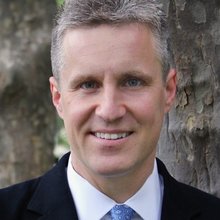Martin Bazant
A Guideline to Limit Indoor Airborne Transmission of COVID-19
Event Details:
Location
This event is open to:

Martin Z Bazant, Ph.D.
E. G. Roos (1944) Professor, Massachusetts Institute of Technology
Chemical Engineering and Mathematics
Signup Here (REQUIRED) Space is Limited
Abstract: A Guideline to Limit Indoor Airborne Transmission of COVID-19
The current revival of the American economy is being predicated on social distancing, notably the Six-Foot Rule of the CDC, which offers little protection from pathogen-bearing aerosol droplets sufficiently small to be mixed through an indoor space. The importance of indoor airborne transmission of COVID-19 is now widely recognized, but no simple safety guideline has been proposed to protect against it. We here build upon models of airborne disease transmission to derive a guideline that bounds the "cumulative exposure time", the product of the number of occupants and their time in an enclosed space. The bound depends on the rates of ventilation and air filtration, dimensions of the room, breathing rate, respiratory activity and face mask use of its occupants, and infectiousness of the respiratory aerosols. By synthesizing data from indoor spreading events with respiratory drop-size distributions, we estimate an infectious dose on the order of ten aerosol-borne virions. The new coronavirus (SARS-CoV-2) is thus inferred to be an order of magnitude more infectious than its forerunner (SARS-CoV), consistent with the pandemic status achieved by COVID-19. Case studies are presented for classrooms and nursing homes, and an online app is provided to facilitate use of our guideline. Implications for contact tracing and quarantining are considered, appropriate caveats enumerated. Particular consideration is given to respiratory jets, which may substantially elevate risk when facemasks are not worn. Finally, the guideline can be expressed as a bound on the safe excess (exhaled) CO2 level in the room for a given time, which enables real-time monitoring of transmission risk using cheap sensors, as well as optimization of HVAC systems to balance infection risk against energy use and cost.
See http://www.mit.edu/~bazant/COVID-19 for publications with John W. M. Bush and others, an online app by Kasim Khan, and a massive open online course (MOOC), 10.S95x Physics of COVID-19 Transmission on edX.
Biography
Martin Z. Bazant is the E. G. Roos (1944) Professor of Chemical Engineering and Mathematics at the Massachusetts Institute of Technology. After a PhD in Physics at Harvard (1997), he joined the MIT faculty in Mathematics (1998) and then in Chemical Engineering (2008). He is a Fellow of the American Physical Society (Division of Fluid Dynamics), the International Society of Electrochemistry, and the Royal Society of Chemistry, and winner of the 2015 Kuznetsov Prize in Theoretical Electrochemistry (ISE), the 2018 Andreas Acrivos Award for Professional Progress in Chemical Engineering (AIChE), the 2019 MITx/edX Prize for Teaching and Learning in Massive Open Online Courses. He also serves as the Chief Scientific Advisor for Saint Gobain Ceramics and Plastics, North America.
Related Topics
Explore More Events
-
Chemical Engineering Colloquium
Julie Elaine Rorrer
Advancing the Catalytic Depolymerization and Upcycling of Plastic Waste-(In Person) Shriram 104 -
PhD Thesis Defense
Valerie A. Niemann PhD Thesis Defense
Understanding Interfaces in Electrochemical Ammonia Synthesis and Waste Valorization-Allen 101X